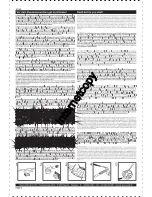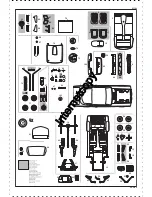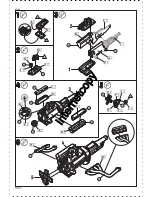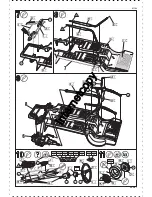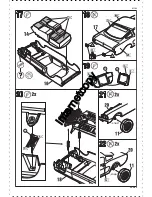
©2009 BY REVELL GmbH & Co. KG
07193-0389
’66 Shelby
®
GT 350 R
™
’66 Shelby
®
GT 350 R
™
1964 präsentierte Ford auf der Weltausstellung in New York ein attraktiv
gestaltetes, sortliches Coupé, das für die „Baby-Boomer-Generation“, die
geburtenstarken Jahrgängen nach dem zweiten Weltkrieg, gedacht war.
Das Fahrzeug sprach ein breites Publikum an und war für einen
erschwinglichen Preis zu haben. Dieser ab April erhältliche Ford Mustang,
der zu dem Stammvater einer ganzen Sportwagengeneration werden
sollte, die sich nach seinem Markenschild „Pony Cars“ nennen wird,
schlug ein wie eine Bombe. In nur einem halben Jahr veräußerte Ford
unglaubliche 680.000 Stück von ihm. Damit schrieb der Mustang als einer
der erfolgreichsten Fahrzeuge aller Zeiten Geschichte in der amerikani-
schen Automobilindustrie. In Fords Bestreben, zu Promotionszwecken
eine Hochleistungssonderversion des Mustangs in begrenzter Auflage zu
produzieren, wand sich das Unternehmen an Carroll Shelby. Shelbys
Cobras wurden schon mit Ford Motoren ausgestattet, so daß es sich
anbot, gezielt den ehemaligen Rennfahrer anzusprechen. Shelby kreierte
den legendären GT 350 auf Basis der neuen Fastback Karosserie und
des V8-Hochleistungsmotors von Ford, wobei Shelby den Wagen noch
weiter tunte. 1965 entstanden über 560 Exemplare des 306 PS starken
Wagens. Mit dem Wagen wollte Ford sogar Rennen fahren. Dem SCCA
(Sports Car Club of Amerika) reichte das Fahrzeug jedoch nicht für die
Rennzulassung in der B/Production Klasse, so daß Ford Shelby um
weitere Modifikationen bat.
Die B/Produktionsklasse des SCCA erlaubte Veränderungen entweder an
dem Motor oder an der Radaufhängung eines bestehenden Wagen, nicht
aber beides. Shelby konzentrierte sich auf den Motor, überarbeitete die
Zylinderköpfe, balancierte innere Teile besser aus und installierte eine
andere Nockenwelle. Mit Rücksicht auf die Härten eines Rennens kamen
eine größere Ölwanne und ein größerer Ölkühler zum Einsatz. Die
Leistung des Ford Motors sprang um knapp 30 Prozent von bisher 271 auf
jetzt 350 PS. Zudem reduzierte Shelby das Gewicht des Wagens um rund
225 Kilogramm, indem er die Motorhaube aus Stahl nicht verwendete,
Rücksitze, Heizung und Kühlanlage, Teppich und weitere Schallisolierun-
gen entfernte. Leichteres Plexiglas ersetzte das schwere Sicherheitsglas
in den Türen. Anstelle der Lüftungsschlitze befand sich jetzt eine
geschlossene, genietete Aluminiumabdeckung an der C-Säule. Hinten
und vorne verschwanden die beiden Stoßstangen, Teile der Frontpartie
bestanden jetzt aus Fiberglas. 36 Fahrzeuge des Shelby GT 350 wurden
zu der spektakulären Rennversion umgebaut und erhielten das Kürzel R
hinter ihrer Bezeichnung.
In 1964, at the New York World Fair, Ford presented an attractive sporty
Coupé designed for the “Baby Boomer” generation, born in the years
following the Second World War. The car appealed to a wide public and
was available at an affordable price. This Ford Mustang that came on
the market in the April and was to become the predecessor of a whole
generation of sports cars called “Pony Cars” after its emblem, took off
like a rocket. In only six months Ford had sold an unbelievable 680,000.
This made the Mustang one of the most successful cars of all time in the
history of the American motor industry. In their efforts to produce a high
performance special limited edition version of the Mustang for promo-
tional purposes, Ford turned to Carroll Shelby. Shelby Cobras were
already equipped with Ford engines so it made sense to approach the
former racing driver. Shelby created the legendary GT 350 on the basis
of the new fastback body and the Ford V8 high performance engine,
with a bit of fine tuning by him. In 1965 over 560 of this 306 bhp car were
made. Ford even wished to run races with it. However, the SCCA
(Sports Car Club of America) did not consider the car suitable to be
licensed for racing in the B production class, so that Ford Shelby were
asked to make further modifications.
The SCCA B production class permitted alterations to be made to either
the engine or the wheel suspension of an existing car, but not to both.
Shelby concentrated on the engine; he revised the cylinder head,
improved the balance of the internal parts and installed another
camshaft. Considering the rigours of a race a larger oil sump and a
larger oil cooler were used. The capacity of the Ford engine jumped up
by a whole 30% from 271 to 350 bhp. In addition Shelby reduced the
weight of the car by about 225 kg, by eliminating the steel bonnet, rear
seats, heating and cooling system. Carpets and other items of sound
insulation were removed. The heavy safety glass in the doors was
replaced by lighter Plexiglas. In place of the ventilation louvers there
was now a closed aluminium cover riveted to the C pillar. The front and
rear bumpers both disappeared. Parts of the front were now made of
fibreglass. 36 of the Shelby GT 350s were converted to this spectacular
racing version and received the extra R in the designation.
’66 Shelby
®
GT 350 R
™
Summary of Contents for Shelby GT350R
Page 2: ...07193 ...
Page 3: ...07193 ...
Page 4: ...07193 ...
Page 6: ...28 28 07193 ...
Page 7: ...93 12 97 17 13 14 15 16 70 4 21 22 23 24 25 26 19 20 3 79 78 77 58 T 7 14 PAGE 7 07193 ...
Page 8: ...8 3 19 73 99 1 2 2 72 95 96 96 40 1 60 61 98 PAGE 8 07193 ...
Page 9: ...20 22 snap snap 52 52 21 PAGE 9 07193 ...
Page 11: ...4 5 8 2 16 9 15 1 18 18 16 12 6 7 14 10 18 13 14 12 6 7 14 11 18 13 14 PAGE 11 07193 ...


